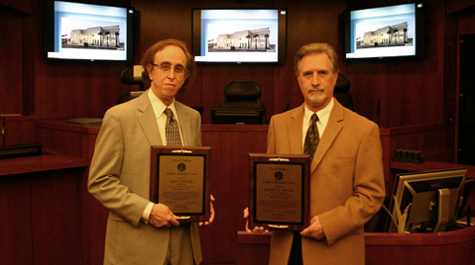CLCT Recognized for Helping Design New Gulfport, Mississippi, Courthouse
In the aftermath of Hurricane Katrina, the city of Gulfport, Mississippi, enlisted the Center for Legal & Court Technology (CLCT) to help redesign its municipal courthouse, which was destroyed in the storm.
CLCT, a joint project of William & Mary Law School and the National Center for State Courts, accepted the project on a pro bono basis. In the years that followed, CLCT staff and students worked with architects to redesign the Gulfport Municipal Court and outfit it with state-of-the-art technology. The new facility opened in February 2011 as part of the Robert J. Curry Public Safety Center. Meanwhile, CLCT continued its long-term commitment to help the Court streamline its operations.
This past January, Gulfport Mayor George Schloegel presented CLCT with a plaque recognizing its contributions to the Hurricane Katrina recovery effort, and thanking CLCT for its years of service.
"Your assistance, in the designing of our court facility and implementation of legal technology in our courtrooms, has established us as a model for municipal courts in Mississippi," said Schloegel in a letter to CLCT.
CLCT took on the project after the city's court administrator visited the Law School and requested CLCT's help in redesigning the courthouse.
The Gulfport Municipal Court is the trial court of first instance for domestic violence cases, criminal and traffic offenses, and environmental matters. After the storm, it was relocated to trailers and then to a former elementary school.
CLCT was on the front lines of redesigning the arraignment and trial courtrooms. The project was led by CLCT's Director and Chancellor Professor of Law Fredric Lederer and CLCT's Deputy Director Martin E. Gruen, who was instrumental in the technology and courtroom designs. Numerous law students also assisted with the project.
"It's very nice to have our work recognized," said Lederer. "I'm particularly pleased that this was a project where our students were so heavily involved."
